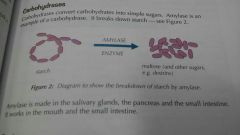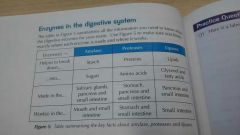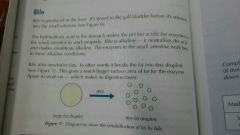![]()
![]()
![]()
Use LEFT and RIGHT arrow keys to navigate between flashcards;
Use UP and DOWN arrow keys to flip the card;
H to show hint;
A reads text to speech;
14 Cards in this Set
- Front
- Back
|
What is mechanical digestion? |
This includes our teeth grinding down our food and our stomach churning up food |
|
|
What is chemical digestion? |
Where enzymes help break down food. |
|
|
What is carbohydrase? |
A type of digestive enzyme that catalyses the break down of starch into sugars in the mouth and the small intestine. |
|
|
What is amylase? |
A digestive enzyme that catalyses the breakdown of starch into sugars, in the mouth and small intestine. |
|
|
Breakdown of starch by amylase |

|
|
|
What is protease? |
A type of digestive enzyme that catalyses the breakdown of proteins into amino acids, in the stomach and small intestine. |
|
|
What is a protein? |
A large biological molecule made up of long chains of amino acids. |
|
|
What is an amino acid? |
A small molecule that is a building block of proteins. |
|
|
Breakdown of proteins by proteases |

|
|
|
What is a lipase? |
A type of digestive enzyme that catalyses the breakdown of lipids into fatty acids and glycerol, in the small intestine. |
|
|
Breakdown of lipases |

|
|
|
Enzymes in the digestive system (table) |

|
|
|
What is bile? |
A fluid that is made in the liver, stored in the gall bladder and released into the small intestine. It aids digestion by creating alkaline conditions in the small intestine by emulsifying fats. |
|
|
Emulsification of bile. |

|

